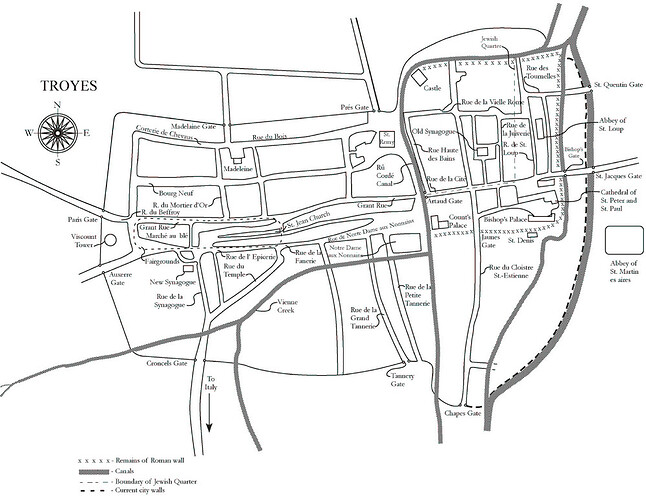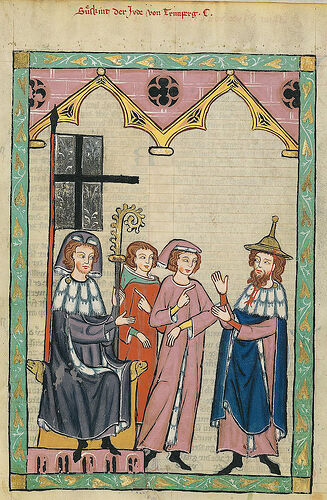Jewish Troyes
Historic - This post describes the Jewish quarter in the city of Troyes in 1220. The goal is to use Troyes as a specific example of the more generic concept of the Jewish quarter. A Jewish quarter is not a ghetto, not a closed and legally enforced area, a concept that would not evolve for a few hundred years. The included map is from the Rashi’s Daughters website and I have been unable to corroborate it, but it might be useful for someone’s saga.
Troyes was once the home of the great scholar Rashi and remains one of the centers of the Tosafist movement in 1220. The town has a population of a couple of thousand people, of which a few hundred are Jewish. The Jews are concentrated in the Jewish Quarter, in the eastern, oldest, part of the city, bounded by a canal of the Seine to the north and west, by the Grand Street to the south, and ending short of the Abbey of St. Loup to the east. The community clusters near Troyes castle, the home of the Bishop of Troyes.
LIke many Jewish communities, they work to maintain a good relationship with the local authorities, even though they are Christian clerics. The Bishop does not want to see murder and chaos in the streets of his town. And so the Jews have sited their homes near his castle so that any violence will be immediately apparent to him. It has even happened in some communities that the Jews, when under threat, have fled into the local castle and been protected inside it.
The Jewish quarter is not strictly inhabited by Jews, and access to it is not restricted at any time. There are no gates or walls around the quarter. While many Christians do not want to live in the company of Jews, some don’t mind it, and they profit by providing services to the community.
Jews in the quarter earn their living much as their Christian neighbors do, there are blacksmiths, coopers, and other craftsmen. Two important jobs that must be filled by Jews are that of the shochet, the animal slaughterer, and the wine merchant. Both of these jobs can only be performed for Jews by other Jews and they require specialized skills, including a Rabbinic Law score of 1.
Troyes, though it has declined somewhat in recent years, is a center of Jewish learning as well. The rabbis of Troyes maintain a beit midrash, a study hall, which serves as a school both for children and for adult Jews who are able to study. The head rabbi, called rabbeinu or our rabbi, earns his living by the fees that students pay the school. Other teachers and rabbis supplement their income by working themselves or they are supported by their wives. Rashi has been dead for one hundred years, but he is still fondly remembered in Troyes. His grandson, Rabbeinu Tam, was the leader of the community until his death fifty years ago. Since his passing the community has persisted, but no great scholars have come from Troyes.
The synagogue is the center of Jewish worship in the city. This building is owned by a wealthy member of the community. Some years ago there was a dispute in which the owner of the building forbid several Jews he did not like from entering to worship. The rabbis settled this matter with the declaration that the synagogue must be open to all or open to none, no one could pick and choose. The matter still, however, breeds bad blood in the community.
The most important center for the women of the community is the mikvah, the ritual bath. This building houses a deep pool lined with stone in its basement. Clever construction directs water down from the rooftop into catch basins and, eventually, to the pool itself. The mikvah attendants are women skilled in the complicated halakhah of filling a mikvah and immersing in it, and have a Rabbinic Law score of 2 or more. The primary users of the mikvah are women who have finished their monthly period. Some men do use the mikvah for their own ritual purity, but it is a women’s domain.
The Jewish Quarter of Troyes is the center of the larger Jewish community of the surrounding area as well. Many Jews in the area do not live in the town, but in small agrarian villages nearby. They travel to Troyes to consult with a rabbi, to immerse in the mikvah, and to sell their produce, especially grapes.
For some years the Jews of Troyes and the surrounding communities have been laboring under an unfortunate law. They are required to wear a special hat, the Jewish cap. This is a hat with a round stiff circular brim that rises to a point. This is intended to warn Christians that they person they are dealing with is a Jew, and to prevent social and sexual relations. While this has been the custom in Troyes for some time, the recent Fourth Lateran Council of 1215 has instituted the wearing of distinctive clothing like this for Jews across Europe, though not all regions are in compliance.
Troyes was subjected to a murderous pogrom one hundred years ago, at the time of the First Crusade. Since then, with the exception of the cap, relations with the local Christians have been quiet. The Jews of the town hope it will continue to be so.
New Minor Social Status Virtue - Shabbos Goy
You are a non-Jewish person who lives in the Jewish Quarter. On Jewish holy days you make yourself available to help your Jewish neighbors by doing activities that they are prohibited from doing. This includes lighting a candle that has gone out, stoking a fire, or other activities that are halachically prohibited for Jews to do but which a non-Jew can perform without issue. You do not earn a meaningful living this way (and you should take a second Social Status Virtue to represent how you do earn a living) but are the beneficiary of gifts from your Jewish neighbors from time to time, like a loaf of challah. At character creation have have an additional 50 experience to spend on Awareness, Folk Ken, Judaic Lore, and Area Lore related to the Jewish community as well as a Reputation with other Christians of -1 Sympathetic to the Jews and a Reputation with Jews of +1 Shabbos Goy.

